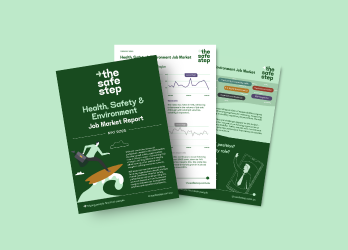Psychosocial Safety in the Workplace: what does success look like?
Page Published Date:
February 12, 2025
Psychosocial Safety in the Workplace: what does success look like?
Creating a safe workplace is so much broader than physical safety - psychological health is just as important. However, it’s much less straightforward for employers to navigate, requiring a holistic and cross functional approach to effectively manage psychosocial hazards and prevent psychological harm.
New Safe Work Australia model legislation introduced last year and being adopted by many states and territories since, has clarified our obligations and understanding of what practical measures are required to foster psychosocial safety in the workplace, but what does success look like?
We captured key takeaways from a recent panel discussion run by The Safe Step and our colleagues at The Next Step. The forum explored which approaches are adding true evidence-based value versus feel good measures for the sake of compliance, and what metrics we should use to determine success as a collaborative People and Safety team. Read on to learn more.

Proven strategies to enhance psychosocial safety in the workplace
Enhance leadership capabilities
Managing and enhancing the psychosocial safety of employees in the workplace may not come naturally to all leaders. In fact, some managers may inadvertently be contributing to the problem by not understanding what is required of their role. That’s why Calvary HealthCare Head of Safety and Organisational Capability Megan Hopkins says it’s important to focus on upskilling leaders with the right tools and skills to create a safe environment and navigate professional boundaries.
“We saw an uplift in complaints of harassment and a whole range of things and what we found the root cause was managers just did not know how to be managers. They did not know how to have an enquiring conversation, as opposed to frustrated or aggressive conversations,” Ms Hopkins says.
“So we looked at how we give tools and set benchmarks for our managers so they know how to lead their people and it’s worked really well…Our turnover rates have dropped, our confidence [rates] and confidence in managers rates have lifted as a result.”
Demystifying policies and procedures with practical guidance
To ensure policies and procedures become part of the fabric of workplace culture, rather than a measure for the sake of compliance, businesses should work to demystify the legal requirements. WorkSafe Victoria’s Principal Psychological Health and Safety Specialist Dr Libby Brook clarifies that having policy and procedures is not enough, businesses should implement an effective psychosocial risk management system and guidance to support that is available on WorkSafe’s website.
People-centered programs can be designed around creating human experiences based on pressures the team may be facing beyond their work such as financial wellbeing.
Leaders should also spend more time opening up communication to enable people to be brave and share their expectations of what a safe and trusted work environment looks like, feels like and sounds like.
Collaboration across People and Safety creates a holistic solution
Managing and enhancing psychosocial safety in the workplace has moved beyond the narrow focus of any one team, towards a proactive and collaborative approach spearheaded by both HR and HSE. By collaborating closely both teams can lean on knowledge, data and strategies to create a shared ownership model that offers a holistic approach to addressing psychosocial risks.
“This space encourages [People and Safety] to hold hands more than ever before,” Ms Hopkins says. “When our employees and managers see that collaboration, it’s comforting, it’s a great role model for everybody that we get on board….It’s a partnership, but with sincerity and authenticity. We need to look at what metrics, what activities, what collaboration is authentic rather than ticking a box.”
Embrace formal audits
Embracing compliance audits is an opportunity to challenge our mindset and ways of working. IAG Executive Manager, Safety and Wellbeing Sean Silvey encourages both HR and HSE teams to embrace audits as an opportunity to better understand what is working and what isn’t, different perspectives and learn from best practice across industry.
“It requires us to be courageous. But it also provides an opportunity to change and learn from what best in class looks like rather than shying away,” Mr Silvey says. “We’ve learned an enormous amount through audits by working together on the solution.’
Key metrics for managing psychosocial safety
Using a data driven approach will enable you to refine and improve interventions over time, ensuring continuous progress. Metrics to consider here include:
- Staff turnover rates
- Absenteeism rates
- Employee sentiment surveys
- Incident reports
- Employee interviews
- Anecdotal feedback
Be aware, however, that metrics are often lag indicators and only form part of the picture. Mr Silvey says the best way to measure the effectiveness of approaches is by listening to employees both one on one and in group forums.
“You’ve got to invest the time in listening to find out the driver behind certain behaviors and problems, that often the data won’t tell you until it’s too late,” he says.
How we can help
The Safe Step and The Next Step work with leading HSE and HR professionals, trained to support the management of psychosocial safety and positive workplace cultures. Please let us know if your organisation needs support on either a temporary or permanent basis.
Or, if you're HR or HSE professional looking to work with an employer who provides healthy culture, please speak to one of our consultants about how we can support you in taking the right next step.
Additional resources
Webinars
- Managing Psychosocial Risk in the Workplace: An informative 1-hr discussion about effective evidence-based ways to manage psychosocial risk. Psychologist David Burroughs, Woolworths' Director of Safety, Health & Wellbeing Jane Bourke, and leading work health and safety lawyer, Steve Bell.
- Managing Psychosocial Risk in the Workplace #2: Steve Bell, David Burroughs and Jane Bourke reunite 6-months on from our first webinar to discuss what's changed in managing psychosocial risk in the the workplace.
- How can employers best support victims and perpetrators of Domestic and Family Violence
Articles
- Managing Psychosocial Risk at Work: 10 Ways to Improve Effectiveness
- Creating a safe space for your own HSE team
Watch key takeaways from the panel
The Safe Step's Principal Consultant, Ramtin Parvar received excellent feedback from the forum. "I really enjoyed facilitating this important discussion, we all walked away from it with useful and actionable ideas and it really reinforced that we don’t need overcomplicate things and the beauty is keeping it simple and risk based," he said.
Watch key takeaways from Ramtin and each of the panellists below.
Many thanks to our expert panel of People and Safety leaders who shared their insights with us: Calvary Health Care Head of Safety and Organisational Capability Megan Hopkins, WorkSafe Victoria’s Principal Psychological Health and Safety Specialist Dr Libby Brook, Australian Gas Infrastructure Group’s Executive General Manager People, Safety and Culture Johanna Birgersson and IAG Executive Manager, Safety and Wellbeing Sean Silvey.




